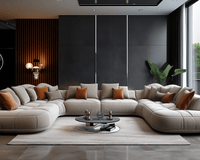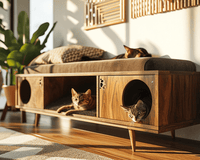Introduction:
Hanging a mirror on the wall may seem like a simple task, but achieving the perfect installation requires careful consideration. Mirrors serve both functional and aesthetic purposes, enhancing the beauty of our living spaces. In this guide, we will explore the art of mirror installation, covering crucial aspects such as wall assessment, location selection, and various hanging methods. From traditional wire installations to modern adhesive solutions, we'll provide a comprehensive overview to help you adorn your walls with mirrors that are not only securely placed but also harmoniously integrated into your home's design.

Preparing for Mirror Installation
When venturing into the task of installing a mirror on your wall, thorough preparation is key to ensuring a successful and visually pleasing outcome. Proper preparation involves understanding your wall structure, selecting the ideal location, and gathering the necessary tools and materials. Let's delve into these crucial aspects:
1. Assessing Wall Structure:
Before you embark on the installation journey, take the time to identify the composition of your walls. Different wall materials, such as drywall, plaster, or concrete, require distinct hanging methods. For example, if you're dealing with drywall, it's essential to locate the studs for added support. Utilizing a stud finder can simplify this process, ensuring that your mirror is anchored securely. In the case of plaster or concrete walls, special anchors or screws may be necessary. Understanding your wall structure sets the foundation for a stable and lasting installation.

2. Choosing the Right Location:
Selecting the optimal location for your mirror is a decision that combines both functionality and aesthetics. Consider the room's lighting, the size of the mirror, and its impact on the overall design. For instance, placing a mirror strategically across from a window can maximize natural light and create the illusion of a more spacious environment. In a bedroom, positioning a mirror adjacent to a closet can serve both practical and decorative purposes. Additionally, following design principles like symmetry and balance contributes to a harmonious visual effect. By thoughtfully choosing the location, you enhance the mirror's functionality while complementing the room's aesthetics.
3. Gathering Necessary Tools and Materials:
Once you've assessed your wall structure and chosen the perfect location, it's time to gather the tools and materials necessary for the installation. Basic tools include a level, measuring tape, pencil, and a drill. Depending on your chosen hanging method, additional items such as screws, anchors, wire, or adhesive hooks may be required. For instance, if you opt for a wire hanging method, ensure you have D-rings and picture wire that can support the mirror's weight. Adhesive solutions might call for strong adhesive strips or hooks designed for heavy items. By having all the required tools and materials on hand, you streamline the installation process and avoid interruptions.
In summary, preparing for mirror installation involves a meticulous approach encompassing the assessment of wall structure, thoughtful selection of the installation location, and gathering the necessary tools and materials. By understanding your walls, choosing an ideal location, and equipping yourself with the right tools, you lay the groundwork for a successful mirror installation that not only enhances the aesthetics of your space but also ensures stability and longevity.

Mirror Hanging Methods
When it comes to hanging mirrors on the wall, the method you choose plays a crucial role in both the aesthetic appeal and stability of the installation. Let's explore four popular mirror hanging methods, each offering a unique approach to achieve a secure and visually pleasing result:
1. Traditional Wire Hanging:
One of the classic methods involves using a wire attached to D-rings secured on either side of the mirror frame. This technique provides flexibility in adjusting the mirror's height and allows for a secure connection to wall hooks. Imagine a vintage-inspired living room adorned with a large ornate mirror. Using a traditional wire hanging method not only ensures the mirror's stability but also adds a touch of timeless elegance to the room.
2. French Cleat Installation:
For those seeking a more modern and visually streamlined approach, French cleats offer an excellent solution. This method involves attaching a cleat to the wall and its counterpart to the mirror's back, allowing for a secure and flush mount. Picture a contemporary bedroom where a frameless mirror seamlessly hangs using a French cleat. This method not only provides stability but also adds a clean, minimalist aesthetic to the space.

3. Adhesive Hooks and Strips:
Ideal for those who prefer a drill-free option, adhesive hooks and strips offer a convenient and damage-free solution. These specially designed hooks and strips can support various mirror weights and adhere to different wall surfaces. Consider a small entryway where a mirror hangs effortlessly using adhesive strips. This method not only simplifies the installation process but also caters to spaces where drilling into walls is not preferred.
4. Mirror Clips for Frameless Mirrors:
Frameless mirrors require a specific approach for a secure installation. Mirror clips, often made of metal or plastic, are used to grasp the edges of the mirror, keeping it firmly in place. Envision a modern bathroom where a frameless mirror is flawlessly secured with mirror clips, creating a sleek and unobtrusive look. This method ensures stability while allowing the mirror's design to shine without the distraction of a visible frame.
In conclusion, choosing the right mirror hanging method involves considering both the aesthetic preferences and structural requirements of your space. Whether you opt for the timeless elegance of traditional wire hanging, the modern simplicity of French cleats, the convenience of adhesive hooks and strips, or the sleek functionality of mirror clips for frameless mirrors, each method has its unique advantages. By selecting the method that aligns with your vision and the characteristics of your space, you can achieve a mirror installation that not only enhances your wall decor but also stands the test of time.

Ensuring Stability and Safety
Ensuring the stability and safety of a wall-mounted mirror is paramount, not only for the longevity of the installation but also for the well-being of those sharing the living space. Let's delve into three critical aspects that contribute to the stability and safety of your mirror installation:
1. Weight Considerations:
Understanding the weight of your mirror is fundamental to selecting appropriate hanging hardware and ensuring a secure installation. Mirrors come in various sizes and materials, each contributing to their overall weight. Begin by checking the manufacturer's specifications for the mirror's weight. Once armed with this information, choose anchors, screws, and support mechanisms that exceed the mirror's weight to provide a safety margin. For instance, if your mirror weighs 30 pounds, opt for anchors and screws rated for 40 pounds or more. This precautionary measure guards against unexpected shifts and ensures the mirror remains steadfast on the wall.
2. Securing Mirrors in Earthquake-Prone Areas:
In regions prone to seismic activity, additional precautions must be taken to secure mirrors and prevent potential hazards during an earthquake. Utilizing earthquake-resistant anchors and brackets can significantly enhance the stability of the installation. For framed mirrors, consider installing L-shaped brackets at the bottom to prevent swinging. Additionally, applying museum putty or earthquake gel to the back corners of the mirror can minimize movement and reduce the risk of shattering. This level of preparation is crucial for safeguarding both the mirror and the occupants of the space in the event of seismic activity.

3. Regular Maintenance and Inspection:
Once your mirror is securely installed, ongoing maintenance and periodic inspections are vital to detect and address any issues promptly. Regularly check the integrity of the hanging hardware, ensuring that screws and anchors remain tight and secure. Inspect the mirror itself for any signs of damage, such as cracks or chips. If your mirror is located in an area with temperature fluctuations, consider how these changes may affect the adhesive or hanging mechanisms. Addressing maintenance issues promptly not only preserves the safety of the installation but also prevents potential damage to the mirror and surrounding areas.
In conclusion, ensuring stability and safety in mirror installation is a multifaceted process that involves meticulous attention to weight considerations, earthquake-prone regions, and ongoing maintenance. By understanding the weight of your mirror, securing it effectively in earthquake-prone areas, and conducting regular inspections, you create a safe and stable environment for your wall decor. A well-maintained mirror not only enhances the aesthetics of your space but also provides peace of mind, knowing that it is securely and safely affixed to the wall.

Conclusion:
In conclusion, mastering the art of wall mirror installation is more than just a practical skill; it's an opportunity to elevate the aesthetics of your living space. By carefully assessing your walls, selecting the right location, and choosing an appropriate hanging method, you can achieve a secure and visually pleasing installation. Whether you opt for the classic elegance of wire hanging or the modern simplicity of adhesive solutions, the key lies in precision and thoughtful consideration of your space.
As you embark on this journey, remember that the placement of mirrors can significantly impact the atmosphere of a room. The reflective surfaces can enhance natural light, create the illusion of space, and contribute to an overall sense of elegance. Regular maintenance ensures the longevity of your installation, allowing you to enjoy the transformative power of mirrors for years to come.
So, whether you're a DIY enthusiast or a homeowner looking to refresh your living space, this guide equips you with the knowledge and tools needed to hang mirrors with confidence. Elevate your home decor and embrace the transformative power of mirrors – a simple yet impactful addition to your walls. Happy mirror hanging!

Call to Action: Elevate Your Space with Secure and Stylish Mirror Installations
Now that you've gained insights into the art of mirror installation, it's time to put this knowledge into action and transform your living space. Follow these three key steps to ensure a secure, stylish, and long-lasting mirror installation:
1. Start with a Comprehensive Plan:
Begin by assessing your walls, understanding their composition, and choosing the perfect location for your mirror. Consider the room's design, lighting, and dimensions to create a plan that seamlessly integrates the mirror into your space. Armed with this plan, gather the necessary tools and materials, ensuring you have everything you need for a successful installation. Whether you opt for traditional wire hanging, a modern French cleat, or a convenient adhesive solution, having a comprehensive plan sets the foundation for a visually pleasing and stable mirror installation.
2. Prioritize Stability and Safety:
When it comes to mirror installation, stability and safety are non-negotiable. Take the time to understand the weight of your mirror and select appropriate hanging hardware that exceeds its specifications. If you reside in earthquake-prone areas, implement additional precautions such as earthquake-resistant anchors and brackets to fortify the installation. Regularly inspect and maintain your mirror to address any issues promptly, ensuring both the safety of your space and the longevity of your wall decor.

3. Explore Your Style, Enhance Your Space:
With a securely installed mirror, it's time to explore the transformative power of reflective surfaces in enhancing your space. Consider different styles and placements that align with your aesthetic preferences and room design. Mirrors have the ability to amplify natural light, create the illusion of space, and add a touch of elegance to any room. Experiment with unique arrangements, frame styles, and mirror sizes to discover the perfect balance that elevates your living environment.
Take the First Step: Elevate Your Home Decor!
Embark on your mirror installation journey with confidence, knowing that you have the knowledge and tools to create a secure and stylish addition to your walls. Whether you're aiming for a classic, modern, or eclectic look, a well-placed mirror can be a game-changer in transforming your living space. Make the first move, implement the steps outlined in this guide, and witness the impact of a thoughtfully installed mirror on the aesthetics and atmosphere of your home.
Don't just hang a mirror – elevate your space and make a statement. Your walls are waiting to become a canvas for stylish and secure mirror installations. Begin your journey today!

Frequently Asked Questions (FAQs): Your Mirror Installation Queries Answered
1. Can I hang a heavy mirror on drywall?
Yes, you can, but it's crucial to choose the right anchors and screws specifically designed for drywall. Ensure an even weight distribution and, when possible, anchor into wall studs for added support. This guarantees a secure installation without compromising your drywall.
2. How do I remove adhesive residue from mirrors?
Removing adhesive residue is simple. Use a gentle adhesive remover or create a solution with warm water and mild soap. Apply the solution with a soft cloth, avoiding abrasive materials that could potentially damage the mirror. This ensures a clean and residue-free surface.
3. Can I hang a mirror without making holes in the wall?
Absolutely. Adhesive hooks and strips provide a drill-free option. Choose hooks or strips based on the weight of your mirror, ensuring they adhere securely to the wall surface. This method not only simplifies the installation process but also prevents any damage to your walls.

4. What's the ideal height for hanging a mirror?
Determining the ideal height depends on the room and its purpose. In living spaces, consider hanging the mirror at eye level for optimal viewing. In bathrooms, factor in functionality and the varying heights of individuals using the mirror regularly. This thoughtful approach ensures both practicality and aesthetic appeal.
5. How do I choose the right size of mirror for a room?
Choosing the right size involves considering the room's dimensions, furniture placement, and overall design aesthetic. A larger mirror can create the illusion of more space, while a well-proportioned mirror enhances visual balance. Take into account the unique characteristics of your space to select a mirror size that complements and elevates your room's decor.
Explore these frequently asked questions to address common concerns and make informed decisions as you embark on your mirror installation journey. If you have additional questions or need personalized assistance, feel free to reach out. Your mirror installation experience should be not only secure but also tailored to enhance the aesthetics of your living space.










